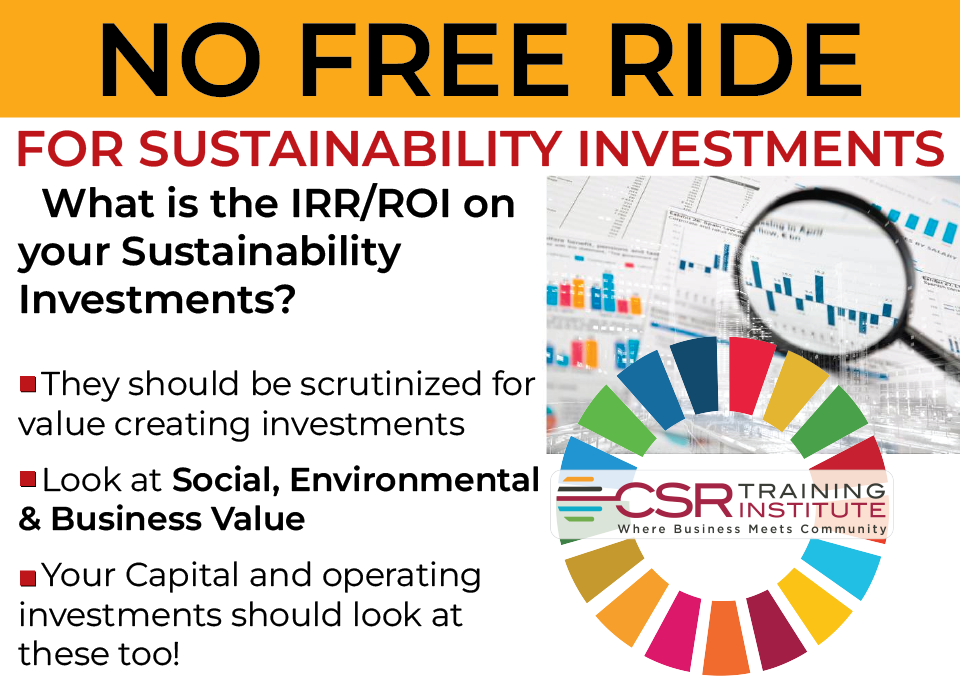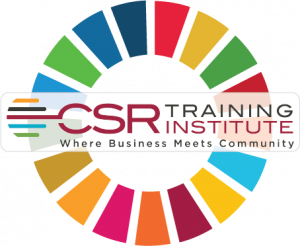Sustainability Investments must produce value and they should be scrutinized, assessed and evaluated with the same rigour and thoroughness as regular capital and operating investments. Too often they get a free ride because they are seen as ‘different’.
That makes no sense and too often results in a misallocation of corporate capital with investment going to areas with sub-optimal returns.
None of this is to say that sustainability investments should be subjected to the same IRR, corporate ROI frameworks as regular operating and capital investments. But, there must be a framework that includes a comparable IRR and ROI that estimates (and has a monitoring and reporting plan) for the value produced.
This must, necessarily, include social and environmental value because of the nature of sustainability investment. And, it must include value flowing back to the business as well.
Too often the sustainability investment decision making framework and process inside a corporation today looks like this.
- Investment Committee and C-Suite Officer realize that sustainability (ESG, CSR, etc.) has become one of the most critical, crosscutting issues the business faces.
- Many of them feel that these investments are somehow different and don’t fit into their IRR/ROI and other frameworks they use for assessing normal investments (e.g. capital and operating)
- They don’t want to appear insensitive to the rapidly increasing importance of sustainability so they often refrain from drilling down into the value metrics, especially as it relates to value for the corporation itself.
- The team that prepares sustainability investment proposals and reports is often not schooled in investment performance issues and the proposals and reports are far too general and qualitative, with not enough quantitative and objective data, especially as it relates to value for the corporation
None of this is to say that sustainability investments are all about quantitative returns for the business, but simply that this must be a consideration of investments will tend to be sub-optimal, with value left on the table. And, too often the value left on the table is value to the business, reducing the ROI/IRR that comes back to the business itself..
As a result, investment proposals, which may be for great projects with amazing benefits, don’t capture all of the potential value. This is not good for the planned social beneficiaries, not good for the planned environmental impacts and definitely not good for the company.

So, what do you do? An investment in community development, a community sports field, an investment in education, an investment in capacity building for local women’s groups doesn’t really fit into the exact same framework as an investment in new operating equipment or an upgrade to a plant or mill.
While they all should go into similar frameworks, too often they don’t. Capital and operating investments go into more quantitative frameworks that focus almost exclusively on corporate value and benefits (and too often simply externalize/ignore social and environmental, other than as required by law)
Sustainability investments often don’t have a structured framework but are evaluated in more of an ad-hoc manner, focusing on qualitative, subjective and external benefits and values. And too often don’t focus sufficiently on (or often totally ignore) internal corporate value and benefits.
The end result is that social, environmental and reputational value may seem to be maximized. However, when corporate value is not fully optimized this can detract from the long term sustainability of the investment program.
The reality is that all investments should be scrutinized through analytical frameworks that take into consideration and force optimization across business, social and environmental value dimensions. Both qualitative and quantitative aspects.
When this is done rigorously and systematically there will be more value produced across all dimensions, making it more likely that the investments can continue and the corporation will thrive.
We need to understand that value should not be a zero sum game.
To conclude, not subjecting all investments to a rigorous and systematic value optimization analysis that directly includes business, social and environmental value, will tend to reduce the value created by the investments.
In a future Thought Piece we will discuss How to Analyze Sustainability Investments
Connect with us on Social Media to be sure you don’t miss our latest insights.


